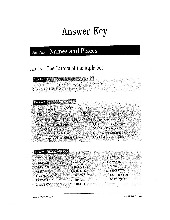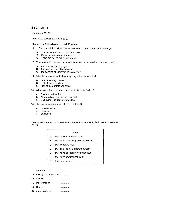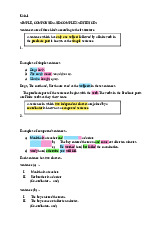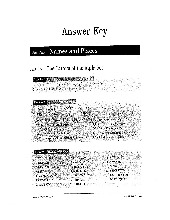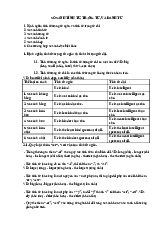








Preview text:
lOMoAR cPSD| 40342981
Taking Action to Reduce Trash! Laura Montague Project Overview
Too quickly, the trash produced in modern civilization is “out of sight, out of mind”. As
society encourages production and use of the products of today, our trash piles are adding
up and causing issues of global proportion across the world. On average, a typical United
States citizen throws away the equivalent of their body weight in trash each month
(Hoornweg, Bhada-Tata, & Kennedy, 2013). When considering this fact in parallel to the
rise of the global population, it is questionable where exactly all of the trash is going and
how our over-use is manifesting into the environment and global community. Issues such
as the Texas-size patch of plastic in the Pacific and Atlantic Ocean (Lovett, 2010), and
the natural resources burned in the production of our trash, are only a few of the global
issues that surround our trash production and disposal. This four-week project will offer
students experiences to inquire into our production and disposal of trash, as they
collaborate with the global community to enrich their understandings and urgency to
invoke change. Upon conclusion of the project, students will have a variety of enduring
understandings surrounding this topic as well as have participated in the creation of a
Reducing Trash campaign with technology tools. References:
Hoornweg, D., Bhada-Tata, P., & Kennedy, C. (2013). Environment: Waste production
must peak this century. Retrieved July 9, 2015.
Lovett, R. (2010). Huge Garbage Patch Found in Atlantic Too. Retrieved July 9, 2015
Targeted Grade Level(s) Grade four lOMoAR cPSD| 40342981 Project Length
This project will take place over three to four weeks. Project Learning Goals
Students will recognize the excess of trash produced across the world alongside the need
to reduce trash production and active utilize responsible waste-disposal practices and strategies. Students will be able to: •
articulate the need for responsible waste-disposal practices. •
identify areas impacted by trash and irresponsible waste disposal practices. •
measure and compare trash production. • reduce their waste •
create a campaign for the need for and ways to execute responsible waste disposal practices. Essential Questions •
What happens to our trash when we throw it away? •
How much trash does the United States produce? •
Where and what are impacted irresponsible waste disposal practices? •
How can we reduce the trash we produce? •
What products produce the least amount of trash? •
How does composting compare to recycling? Which is a better practice? How
can we contribute to global reduction in trash production?
Enduring Understandings •
Students will understand that trash production and disposal is impacting the
environment, animals, and people of the world. •
Students will understand that responsible alternatives to waste disposal include
composting, recycling, and reusing. •
Students will understand that reducing trash involves purchasing and eating
products of organic materials. •
Students will understand that composting is a more responsible alternative to recycling and reusing.
National and State Standards Social Studies:
4.H.1.3 Explain how people, events and developments brought about changes to
communities in various regions of N.C.
4.G.1.1 Summarize changes that have occurred in North Carolina since statehood
(population growth, transportation, communication, landscape). lOMoAR cPSD| 40342981
4.G.1.2 Explain the impact that human activity has on the availability of natural resources in North Carolina.
4.E.1.2 Understand how scarcity and choice in a market economy impacts business decisions. Science:
4.L.1.1 Give examples of changes in an organism’s environment that are beneficial to it and some that are harmful.
4.L1.3 Explain how humans can adapt their behavior to live in changing habitats (e.g.,
recycling wastes, establishing rain gardens, planting trees and shrubs to prevent flooding and erosion). Math:
CCSS.MATH.CONTENT.4.MD.A.2 Use the four operations to solve word
problems involving distances, intervals of time, liquid volumes, masses of objects,
and money, including problems involving simple fractions or decimals, and
problems that require expressing measurements given in a larger unit in terms of a
smaller unit. Represent measurement quantities using diagrams such as number
line diagrams that feature a measurement scale.
CCSS.MATH.CONTENT.4.MD.B.4 Make a line plot to display a data set of
measurements in fractions of a unit (1/2, 1/4, 1/8). Solve problems involving
addition and subtraction of fractions by using information presented in line plots. Language Arts:
CCSS.ELA-LITERACY.L.4.6 Acquire and use accurately grade-appropriate
general academic and domain-specific words and phrases, including those that
signal precise actions, emotions, or states of being (e.g., quizzed, whined,
stammered) and that are basic to a particular topic (e.g.,wildlife, conservation, and
endangered when discussing animal preservation). ICT Integration
Being a twenty-first century project, students will utilize technology tools throughout the
project to foster their understanding and sharing of learning. Throughout this projects students are expected to… •
utilize LessonPath.com to access learning resources including articles, videos,
and interactive activities to develop a foundational knowledge of waste overproduction and disposal. •
research data surrounding measurements of waste disposal within the United States and across the world. •
collaborate with students across the globe with epals.com to discuss waste
production and disposal in varying parts of the world. •
collaborate with students in a different country to brainstorm solutions to the
waste disposal issue on a local and global level. lOMoAR cPSD| 40342981 •
utilize cartooning tools such a powtoon.com to create an original video to
campaign responsible consumer and waste disposal practices.
Proposed Calendar of Activities and Exchanges. Week Phase of Inquiry Cycle
Description of Activities and Exchanges 1 Tuning In
Students will begin estimating and measuring the
trash produced in-class each day. A discussion Introduction to the global
surrounding what products contribute to the class’ issue of waste disposal.
production of trash the most begin and students
Students will work independently, in pairs, or in
small groups to navigate and negotiate meaning
from a pre-made learning playlist from the
website lessonpaths.com. Here, students gain
access to resources including articles, videos, and
interactive activities to develop a foundational
knowledge of the responsible waste production and disposal.
Class will create a “Y” chart to determine what
they “think they know” and what they “want to
know”. Here, students determine what they find
interesting about the topic and determine which
direction each student will take to learn more
about this global issue based on their personal inquiries. lOMoAR cPSD| 40342981 1 Finding Out
Students work independently, in pairs, or in small
groups to determine which resources will help Students explore resources
them learn more about the direction they are to negotiate meanings
taking with their inquiries. Teacher assists students surrounding their personal
in finding and accessing resources to meet their inquiries. needs as inquirers.
For example - Students may inquire into how the
United States compares to other countries in the
world in terms of waste production. Other students
may inquire into how citizens of other regions
dispose of their waste. Teachers may prompt
students to post on a blog, epals.com, or
purposefully arrange a pen pal from targeted
regions to discuss waste production and disposal practices. 2 Sorting Out
Class convenes to share information students have
Students collaborate among gained surrounding their inquiries. Students take each other to determine
turns to share the questions they are exploring relevant information from
about the global issue alongside the information irrelevant information.
they gained from their research. As students share,
the teacher prompts students to determine which
information is the most relevant to targeted
inquiries of the students. If students are
collaborating with people from other parts of the
globe, it is recommended that this information is
documented on a classroom map to foster
geographical understandings and the determining
of possible relationships between findings. By the
end of the discussion, the class has create a
concise and explicit compilation of information
that pertains directly to student inquiries
established in the “Tuning In” phase. lOMoAR cPSD| 40342981 2 Going Further
As students begin to explore their possibilities for Students establish a
sharing their learning with the local and/or global
platform and information to community, it is recommended that teacher expose be shared with the local
students to exemplars of student-made and/or global community.
presentations with technology tools to better Students then create their
enable students to decide how they will share their presentation.
learning. Possibilities of technology tools for
utilization include Powtoon.com, BitStips.com,
photopeach.com, the Lego Movie Maker app, or animoto.com.
Once the students decide how they will share their
information, they can work on iPads or in a
computer lab to create their presentation of the
relevant information established in the “Sorting Out” phase. 3
Students share the presentations they created Making Conclusions
using their technology tools with their class or the
global community through a blog or Skype. Once students have created
Students then reflect on what they have learned and shared their
for their project and how it relates to the global
presentation made with their issue of irresponsible waste production and technology tool, they
disposal. Students must establish which audiences
develop concise conclusions would about their learning and
benefit from viewing their creation and learning
how it relates to their world. what they have learned. To do this, students may
choose to discuss with a collaborative group to
determine the best-fit audience and how their
learning relations to their own world and personal actions. lOMoAR cPSD| 40342981 3 Taking Action
Now that students have determined enduring Students put their learning
understandings surrounding their inquiry project to work by taking action in
and the inquiry projects of their classmates, in their own world to
students take action as they see fit. Actions may contribute to the need for
include; choosing to only eat from reusable responsible waste
containers, kickstarting a school recycling or production and disposal.
composting program, writing letters to
government officials to urge stricter
environmental laws surrounding waste production
and disposal, creating a school garden to offset
carbon emissions from production and to make
use of compost, or participating in a “Zero-Waste” day/week/month/life!
Project Assessment with Scoring Rubric Essential Lacks Elements Needs Further Successfully Includes Project Design Development of Features of the Element Elements Elements Inquiry
My inquiry question is My inquiry question is My inquiry question is Question
not related to the issue moderately related to directly related to the of irresponsible waste the issue of issue of irresponsible disposal. irresponsible waste waste disposal. disposal. Research I chose research I chose research I chose research Resources resources that are resources that are resources that are unrelated to authentic and authentic and developing my
contributed little to my contributed to my understanding of my understanding of my understanding of my inquiry question. inquiry question. inquiry question.
Knowledge and I can not accurately
I can explain with little I can accurately
Understanding explain how the accuracy how the explain how the of the Global current state of waste current state of waste current state of waste Issue disposal is a global disposal is a global disposal is a global issue and how it is issue and how it is issue and how it is
affecting the local and affecting the local and affecting the local and global community. global community. global community. lOMoAR cPSD| 40342981
Technology Tool My presentation does
My presentation shows My presentation shows Presentation not show my little understanding of my deep understanding understanding of the the global need for of the global need for global need for responsible waste responsible waste responsible waste disposal by including disposal by including disposal by not little relevant little relevant including relevant information and few information and few information and
examples of the effects examples of the effects
examples of the effects of irresponsible waste of irresponsible waste of irresponsible waste disposal. disposal. disposal. Taking Action I can not explain how
I can explain with little I can explain how my my idea for taking detail how my idea for idea for taking action action positively
taking action positively positively contributes contributes to the contributes to the to the global issue of global issue of global issue of irresponsible waste irresponsible waste irresponsible waste disposal. disposal. disposal. Cooperation Throughout this Throughout this Throughout this and project, I did not project, I cooperated project, I cooperated Participation cooperate and and participated with and participated with participate with my my peers in a my peers in a peers in order to moderately respectful respectful manner in deepen my manner in order to order to deepen my understanding of the deepen my understanding of the global need for understanding of the global need for responsible waste global need for responsible waste production and responsible waste production and disposal practices.
production and disposal disposal practices. practices. Resource Compilation Articles:
Hoornweg, D., Bhada-Tata, P., & Kennedy, C. (2013). Environment: Waste production
must peak this century. Retrieved July 9, 2015.
Lovett, R. (2010). Huge Garbage Patch Found in Atlantic Too. Retrieved July 9, 2015. Books:
Beavan, C. (2009). No impact man. London: Piatkus. lOMoAR cPSD| 40342981
Johnson, B. (2013). Zero waste home: The ultimate guide to simplifying your life by
reducing your waste. Scribner.
Porter, E. (2013). What's sprouting in my trash?: A book about composting. Capstone Press.
Siddals, M., & Wolff, A. (2010). Compost stew: An A to Z recipe for the earth. Penguin Random House.
Children’s Literature:
McMullan, K., & McMullan, J. (2002). I stink! New York: Joanna Cotler Books.
Sensel, J., & Bivins, C. (2000). The garbage monster. Enumclaw, Wash.: Dream Factory Books.
Starr, E., & Balkovek, J. (2010). Rascal & Shady recycle & reuse. S.l.: Elizabeth Starr. Films:
Dive! A Film by Jeremy Seifert [Motion picture]. (2009).
No impact man [Motion picture]. (2009). Oscilloscope Laboratories. Project:
The No Impact Experiment - No Impact Project. (2009, August 14). Retrieved July 13, 2015.
Technology Tools:
Animoto. (n.d.). Retrieved July 13, 2015.
Bitstrips. (n.d.). Retrieved July 13, 2015.
EPals. (n.d.). Retrieved July 13, 2015.
PowToon - Brings Awesomeness to your presentations. (n.d.). Retrieved July 13, 2015.
LEGO® Movie Maker. (n.d.). Retrieved July 13, 2015.
LessonPaths - Create, share and explore Learning Playlists. (n.d.). Retrieved July 13, 2015.
Skype. (n.d.). Retrieved July 13, 2015.
